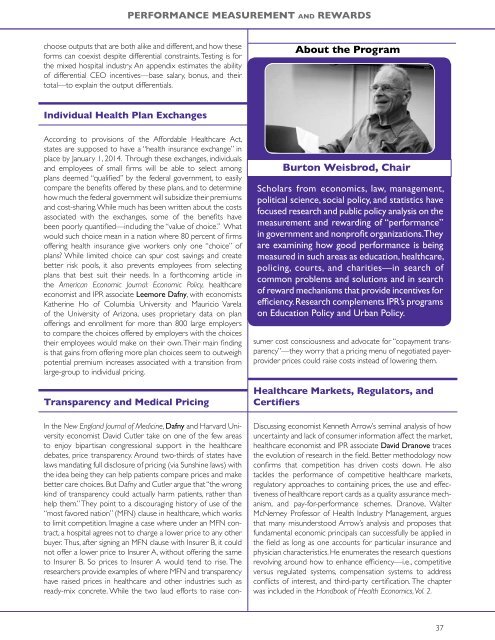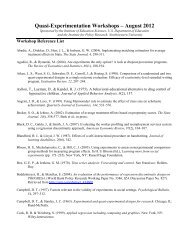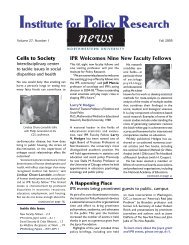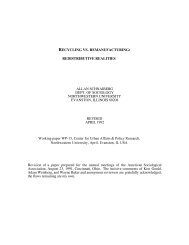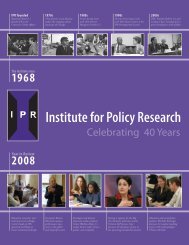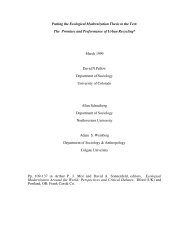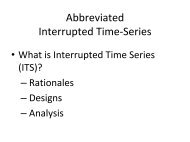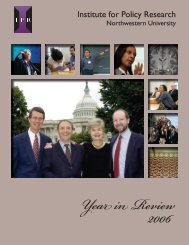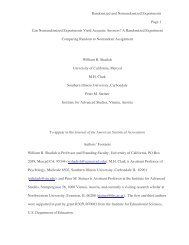Highlights of 2011 - Institute for Policy Research - Northwestern ...
Highlights of 2011 - Institute for Policy Research - Northwestern ...
Highlights of 2011 - Institute for Policy Research - Northwestern ...
You also want an ePaper? Increase the reach of your titles
YUMPU automatically turns print PDFs into web optimized ePapers that Google loves.
per<strong>for</strong>mance measurement and Rewards<br />
choose outputs that are both alike and different, and how these<br />
<strong>for</strong>ms can coexist despite differential constraints. Testing is <strong>for</strong><br />
the mixed hospital industry. An appendix estimates the ability<br />
<strong>of</strong> differential CEO incentives—base salary, bonus, and their<br />
total—to explain the output differentials.<br />
About the Program<br />
Individual Health Plan Exchanges<br />
According to provisions <strong>of</strong> the Af<strong>for</strong>dable Healthcare Act,<br />
states are supposed to have a “health insurance exchange” in<br />
place by January 1, 2014. Through these exchanges, individuals<br />
and employees <strong>of</strong> small firms will be able to select among<br />
plans deemed “qualified” by the federal government, to easily<br />
compare the benefits <strong>of</strong>fered by these plans, and to determine<br />
how much the federal government will subsidize their premiums<br />
and cost-sharing. While much has been written about the costs<br />
associated with the exchanges, some <strong>of</strong> the benefits have<br />
been poorly quantified—including the “value <strong>of</strong> choice.” What<br />
would such choice mean in a nation where 80 percent <strong>of</strong> firms<br />
<strong>of</strong>fering health insurance give workers only one “choice” <strong>of</strong><br />
plans? While limited choice can spur cost savings and create<br />
better risk pools, it also prevents employees from selecting<br />
plans that best suit their needs. In a <strong>for</strong>thcoming article in<br />
the American Economic Journal: Economic <strong>Policy</strong>, healthcare<br />
economist and IPR associate Leemore Dafny, with economists<br />
Katherine Ho <strong>of</strong> Columbia University and Mauricio Varela<br />
<strong>of</strong> the University <strong>of</strong> Arizona, uses proprietary data on plan<br />
<strong>of</strong>ferings and enrollment <strong>for</strong> more than 800 large employers<br />
to compare the choices <strong>of</strong>fered by employers with the choices<br />
their employees would make on their own. Their main finding<br />
is that gains from <strong>of</strong>fering more plan choices seem to outweigh<br />
potential premium increases associated with a transition from<br />
large-group to individual pricing.<br />
Transparency and Medical Pricing<br />
Burton Weisbrod, Chair<br />
Scholars from economics, law, management,<br />
political science, social policy, and statistics have<br />
focused research and public policy analysis on the<br />
measurement and rewarding <strong>of</strong> “per<strong>for</strong>mance”<br />
in government and nonpr<strong>of</strong>it organizations. They<br />
are examining how good per<strong>for</strong>mance is being<br />
measured in such areas as education, healthcare,<br />
policing, courts, and charities—in search <strong>of</strong><br />
common problems and solutions and in search<br />
<strong>of</strong> reward mechanisms that provide incentives <strong>for</strong><br />
efficiency. <strong>Research</strong> complements IPR’s programs<br />
on Education <strong>Policy</strong> and Urban <strong>Policy</strong>.<br />
In the New England Journal <strong>of</strong> Medicine, Dafny and Harvard University<br />
economist David Cutler take on one <strong>of</strong> the few areas<br />
to enjoy bipartisan congressional support in the healthcare<br />
debates, price transparency. Around two-thirds <strong>of</strong> states have<br />
laws mandating full disclosure <strong>of</strong> pricing (via Sunshine laws) with<br />
the idea being they can help patients compare prices and make<br />
better care choices. But Dafny and Cutler argue that “the wrong<br />
kind <strong>of</strong> transparency could actually harm patients, rather than<br />
help them.” They point to a discouraging history <strong>of</strong> use <strong>of</strong> the<br />
“most favored nation” (MFN) clause in healthcare, which works<br />
to limit competition. Imagine a case where under an MFN contract,<br />
a hospital agrees not to charge a lower price to any other<br />
buyer. Thus, after signing an MFN clause with Insurer B, it could<br />
not <strong>of</strong>fer a lower price to Insurer A, without <strong>of</strong>fering the same<br />
to Insurer B. So prices to Insurer A would tend to rise. The<br />
researchers provide examples <strong>of</strong> where MFN and transparency<br />
have raised prices in healthcare and other industries such as<br />
ready-mix concrete. While the two laud ef<strong>for</strong>ts to raise consumer<br />
cost consciousness and advocate <strong>for</strong> “copayment transparency”—they<br />
worry that a pricing menu <strong>of</strong> negotiated payerprovider<br />
prices could raise costs instead <strong>of</strong> lowering them.<br />
Healthcare Markets, Regulators, and<br />
Certifiers<br />
Discussing economist Kenneth Arrow’s seminal analysis <strong>of</strong> how<br />
uncertainty and lack <strong>of</strong> consumer in<strong>for</strong>mation affect the market,<br />
healthcare economist and IPR associate David Dranove traces<br />
the evolution <strong>of</strong> research in the field. Better methodology now<br />
confirms that competition has driven costs down. He also<br />
tackles the per<strong>for</strong>mance <strong>of</strong> competitive healthcare markets,<br />
regulatory approaches to containing prices, the use and effectiveness<br />
<strong>of</strong> healthcare report cards as a quality assurance mechanism,<br />
and pay-<strong>for</strong>-per<strong>for</strong>mance schemes. Dranove, Walter<br />
McNerney Pr<strong>of</strong>essor <strong>of</strong> Health Industry Management, argues<br />
that many misunderstood Arrow’s analysis and proposes that<br />
fundamental economic principals can successfully be applied in<br />
the field as long as one accounts <strong>for</strong> particular insurance and<br />
physician characteristics. He enumerates the research questions<br />
revolving around how to enhance efficiency—i.e., competitive<br />
versus regulated systems, compensation systems to address<br />
conflicts <strong>of</strong> interest, and third-party certification. The chapter<br />
was included in the Handbook <strong>of</strong> Health Economics, Vol. 2.<br />
37


